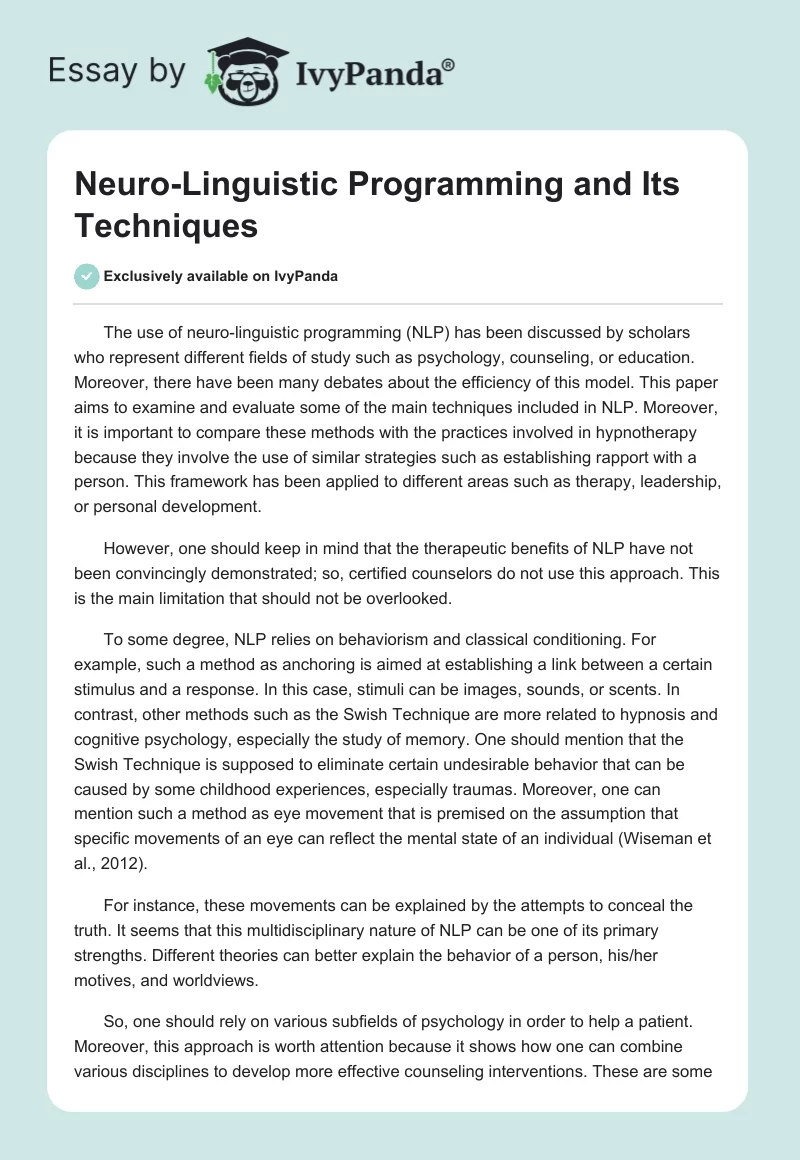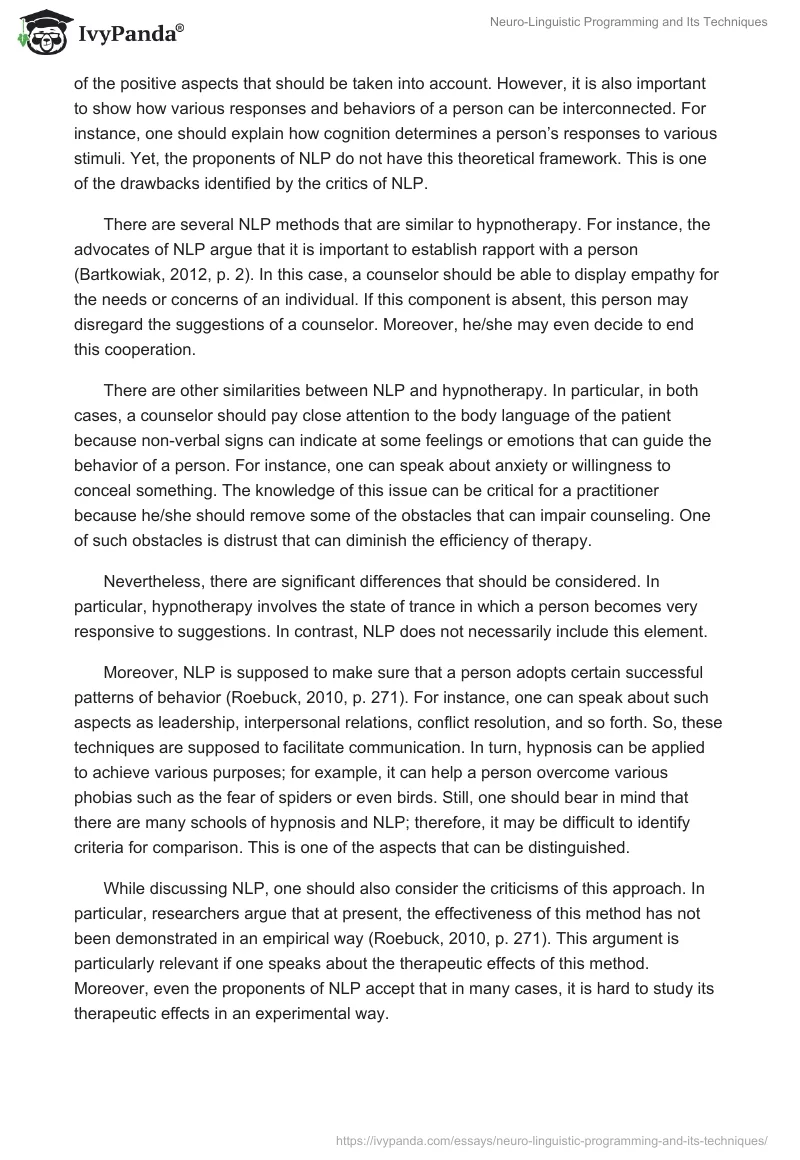The use of neuro-linguistic programming (NLP) has been discussed by scholars who represent different fields of study such as psychology, counseling, or education. Moreover, there have been many debates about the efficiency of this model. This paper aims to examine and evaluate some of the main techniques included in NLP. Moreover, it is important to compare these methods with the practices involved in hypnotherapy because they involve the use of similar strategies such as establishing rapport with a person. This framework has been applied to different areas such as therapy, leadership, or personal development.
However, one should keep in mind that the therapeutic benefits of NLP have not been convincingly demonstrated; so, certified counselors do not use this approach. This is the main limitation that should not be overlooked.
To some degree, NLP relies on behaviorism and classical conditioning. For example, such a method as anchoring is aimed at establishing a link between a certain stimulus and a response. In this case, stimuli can be images, sounds, or scents. In contrast, other methods such as the Swish Technique are more related to hypnosis and cognitive psychology, especially the study of memory. One should mention that the Swish Technique is supposed to eliminate certain undesirable behavior that can be caused by some childhood experiences, especially traumas. Moreover, one can mention such a method as eye movement that is premised on the assumption that specific movements of an eye can reflect the mental state of an individual (Wiseman et al., 2012).
For instance, these movements can be explained by the attempts to conceal the truth. It seems that this multidisciplinary nature of NLP can be one of its primary strengths. Different theories can better explain the behavior of a person, his/her motives, and worldviews.
So, one should rely on various subfields of psychology in order to help a patient. Moreover, this approach is worth attention because it shows how one can combine various disciplines to develop more effective counseling interventions. These are some of the positive aspects that should be taken into account. However, it is also important to show how various responses and behaviors of a person can be interconnected. For instance, one should explain how cognition determines a person’s responses to various stimuli. Yet, the proponents of NLP do not have this theoretical framework. This is one of the drawbacks identified by the critics of NLP.
There are several NLP methods that are similar to hypnotherapy. For instance, the advocates of NLP argue that it is important to establish rapport with a person (Bartkowiak, 2012, p. 2). In this case, a counselor should be able to display empathy for the needs or concerns of an individual. If this component is absent, this person may disregard the suggestions of a counselor. Moreover, he/she may even decide to end this cooperation.
There are other similarities between NLP and hypnotherapy. In particular, in both cases, a counselor should pay close attention to the body language of the patient because non-verbal signs can indicate at some feelings or emotions that can guide the behavior of a person. For instance, one can speak about anxiety or willingness to conceal something. The knowledge of this issue can be critical for a practitioner because he/she should remove some of the obstacles that can impair counseling. One of such obstacles is distrust that can diminish the efficiency of therapy.
Nevertheless, there are significant differences that should be considered. In particular, hypnotherapy involves the state of trance in which a person becomes very responsive to suggestions. In contrast, NLP does not necessarily include this element.
Moreover, NLP is supposed to make sure that a person adopts certain successful patterns of behavior (Roebuck, 2010, p. 271). For instance, one can speak about such aspects as leadership, interpersonal relations, conflict resolution, and so forth. So, these techniques are supposed to facilitate communication. In turn, hypnosis can be applied to achieve various purposes; for example, it can help a person overcome various phobias such as the fear of spiders or even birds. Still, one should bear in mind that there are many schools of hypnosis and NLP; therefore, it may be difficult to identify criteria for comparison. This is one of the aspects that can be distinguished.
While discussing NLP, one should also consider the criticisms of this approach. In particular, researchers argue that at present, the effectiveness of this method has not been demonstrated in an empirical way (Roebuck, 2010, p. 271). This argument is particularly relevant if one speaks about the therapeutic effects of this method. Moreover, even the proponents of NLP accept that in many cases, it is hard to study its therapeutic effects in an experimental way.
This issue can be a critical flaw of NLP because every scientific model should be testable or falsifiable. It should be mentioned that the efficiency of hypnotherapy has been tested in various empirical studies, and it is viewed as one of the valid approaches to therapy. So, certified counselors often apply it. In contrast, NLP is not regarded as a valid technique by therapists (Roebuck, 2010, p. 271). This is one of the details that should be taken into consideration.
Nevertheless, it is important to mention that this method has been applied in certain areas. For instance, this technique has been used in such areas as personnel section in various organizations (Gheorghe, 2013). Moreover, NLP is widely applied to such areas as the development of leadership skills, sales, team-building, negotiations and other fields requiring well-developed communicative or interpersonal skills.
So, NLP attracts the attention of many people who act as business administrators. Overall, many individuals want to get a better idea about NLP because they want to become more efficient interlocutors. However, in this case, one cannot empirically demonstrate that these interventions do help people develop the skills related to communication and persuasion. This is one of the points that can be made.
On the whole, this discussion indicates that NLP involves the use of various psychological fields such as behaviorism and the study of cognitive processes. To a great extent, this model bears some resemblance to hypnotherapy since, in both cases, practitioners focus on building rapport and understanding body language. However, the alleged benefits of NLP should be viewed critically because there is no substantial evidence that can illustrate the efficiency of this method. However, this limitation does not mean that this approach should be rejected because later research may indicate that this method can substantially help patients requiring therapy. The critical task is to design studies showing that this intervention is effective. These are the main aspects that can be distinguished.
Reference List
Bartkowiak, J. (2012). NLP in qualitative research. International Journal Of Market Research, 54(4), 451-453. Web.
Gheorghe, I. (2013). Application of NLP Principles and Methods in the Personnel Recruitment and Selection Process. Economic Insights – Trends & Challenges, 65(1), 159-166. Web.
Roebuck, K. (2010). Emotional Intelligence: High-impact Strategies – What You Need to Know: Definitions, Adoptions, Impact, Benefits, Maturity, Vendors. New York, NY: Emereo Publishing. Web.
Wiseman, R., Watt, C., Brinke, L., Porter, S., Couper, S., & Rankin, C. (2012). The eyes don’t have it: lie detection and Neuro-Linguistic Programming. Plos One, 7(7), 1-5. Web.


